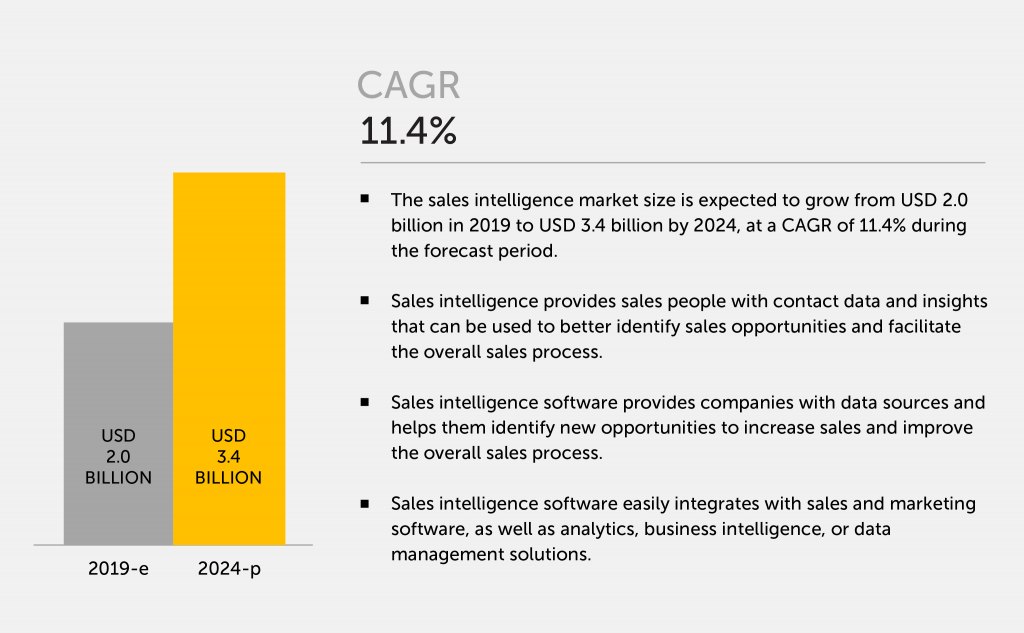Throughout much of modern history, the sales process has predominantly followed a reactive approach. Although sales professionals may take proactive steps to engage with customers, a deeper understanding of the individual’s needs and preferences is often required before crafting a tailored sales proposal.
However, adhering to traditional sales methods doesn’t mean there isn’t room for innovation and change.
Intelligence is the key to success. From AI tools for prospecting to help desk tools, artificial intelligence, sales intelligence and market intelligence have proved to be the game changers. Businesses rely on two crucial forms of intelligence: Sales Intelligence and Market Intelligence. While these terms may sound similar, they serve distinct purposes and are essential for different aspects of a business strategy. Understanding the differences between Sales Intelligence and Market Intelligence is crucial for any company looking to make informed decisions and gain a competitive edge in their industry.

What is Sales Intelligence?
Sales Intelligence, often referred to as SI, is a subset of business intelligence that focuses specifically on the sales process. It involves collecting and analyzing data related to your current and potential customers, as well as your competitors. The primary goal of Sales Intelligence is to help sales teams improve their effectiveness by providing them with the right information at the right time. According to the latest report from MarketsandMarkets, the Global sales intelligence market size to reach USD 3.4 billion by 2024.

Image Source: MarketsandMarkets
Key Components of Sales Intelligence:
1. Customer Profiles
Creating detailed customer profiles involves gathering comprehensive information about your customers. This includes not only basic demographics like age, gender, location, and income but also their preferences, purchase history, past interactions with your company, and feedback. By building rich and multifaceted profiles, sales teams can gain a profound understanding of each customer’s unique needs and desires. This knowledge allows them to craft personalized sales pitches, recommend products or services that align with the customer’s preferences, and offer tailored solutions that are more likely to result in successful sales.
2. Lead Generation
Successful lead generation is about more than just acquiring contact information. It requires a thorough understanding of potential leads and prospects. This means going beyond surface-level data and delving into the pain points and challenges these individuals or businesses face. By identifying the specific needs of potential customers, sales teams can approach them with targeted solutions, making it more likely that these leads will convert into paying customers. Effective lead generation often involves data analysis and segmentation to prioritize leads with the highest conversion potential.
3. Competitor Analysis
Competitor analysis is a critical aspect of Sales Intelligence. It goes beyond merely recognizing who your competitors are; it involves studying their strategies, strengths, and weaknesses in depth. This analysis can reveal opportunities for differentiation and gaining a competitive advantage. For instance, by understanding what sets your competitors apart and where they fall short, your sales teams can position your products or services more effectively, highlight unique selling points, and address potential objections that customers might have based on their experiences with competitors.
4. Sales Funnel Analysis
Sales Intelligence also encompasses a holistic view of the sales process through sales funnel analysis. This involves closely monitoring each customer journey stage, from initial lead generation to the final conversion. By doing so, sales teams can pinpoint bottlenecks, identify areas for improvement, and optimize their sales processes. This data-driven approach helps ensure that resources are allocated efficiently and sales efforts are focused on the most promising leads and opportunities.
5. Customer Relationship Management (CRM)
A robust CRM system is the backbone of Sales Intelligence. CRM software allows sales teams to maintain a centralized customer information database, track interactions, and manage sales pipelines effectively. By automating routine tasks and providing a 360-degree view of customer relationships, CRM tools empower sales professionals to nurture leads, follow up at the right times, and provide a seamless and personalized customer experience.
6. Predictive Analytics
Predictive analytics is a cutting-edge aspect of Sales Intelligence that leverages data and algorithms to anticipate customer behavior, sales trends, and future opportunities. By analyzing historical data and patterns, predictive analytics can help sales teams identify which leads are most likely to convert, forecast sales volumes accurately, and even recommend strategies for upselling or cross-selling to existing customers. This forward-looking approach allows sales professionals to proactively target high-value prospects and tailor their strategies for maximum impact.
Sales Intelligence equips sales teams with a comprehensive toolkit for understanding, engaging, and converting customers. It empowers them to operate strategically, leverage data-driven insights, and build lasting customer relationships, ultimately driving revenue growth and business success.
What is Market Intelligence?
Market Intelligence, often referred to as MI, is a broader concept that encompasses a wide range of activities related to understanding the market and industry in which a company operates. It goes beyond the sales process and takes a more holistic view of the business environment. Market Intelligence is crucial for making informed strategic decisions, identifying opportunities and threats, and staying competitive.
Key Components of Market Intelligence:
1. Market Research
Conducting in-depth research to understand market dynamics, customer behaviors, and emerging trends. This involves analyzing data from various sources, such as surveys, reports, and industry publications.
2. Competitive Analysis
Evaluating competitors’ products, pricing strategies, marketing efforts, and market share to gain insights into the competitive landscape.
3. Regulatory and Compliance Monitoring
Keeping abreast of industry regulations, government policies, and compliance requirements that may impact the business.
4. Consumer Insights
Gathering information about consumer preferences, buying habits, and attitudes to tailor products and marketing strategies accordingly.
5. Industry Benchmarking
Comparing your company’s performance and metrics to industry standards to identify areas for improvement.
6. Risk Assessment
Evaluating potential risks and threats to the business, including economic, political, and technological factors.
Here’s an interesting fact – Approximately 70% to 80% of intelligence is believed to be embedded within an organization’s workforce or its internal Market Intelligence network. These individuals are the ones who accumulate valuable information through their interactions with suppliers, customers, and other industry contacts.
Market Intelligence serves a broader purpose, helping businesses make strategic decisions beyond sales. It is essential for product development, marketing strategies, and long-term business planning.
Key Differences between Sales Intelligence and Market Intelligence:
Let’s explore each of these key differences between Sales Intelligence and Market Intelligence in greater detail:
1. Scope
Sales Intelligence:
As the name suggests, Sales Intelligence primarily concerns itself with the sales process. It involves collecting and analyzing data related to customer interactions, lead generation, and the sales funnel. The scope of Sales Intelligence is relatively narrow, focusing on optimizing the steps leading to closing a sale.
Market Intelligence:
In contrast, Market Intelligence casts a wider net. It seeks to understand the entire market and industry landscape, encompassing not only the sales process but also market trends, competitor strategies, regulatory factors, and more. The scope of Market Intelligence is comprehensive and strategic, allowing businesses to make informed decisions about their positioning in the market.
2. Purpose
Sales Intelligence:
The primary purpose of Sales Intelligence is to boost revenue and enhance sales effectiveness. It equips sales teams with the insights and tools they need to close deals successfully and increase the bottom line. Sales Intelligence is geared toward immediate sales-related goals.
Market Intelligence:
Market Intelligence serves a broader purpose. Its main objectives include strategic decision-making, risk assessment, and market positioning. A holistic view of the market enables businesses to make long-term plans, mitigate risks, and adapt to changing market conditions.
3. Audience
Sales Intelligence:
The primary audience for Sales Intelligence platform is the sales team. It equips sales professionals with the information and strategies to engage with customers and convert leads into sales.
Market Intelligence:
Market Intelligence has a wider audience, including sales, marketing, product development, and executive leadership. Marketing teams use it to refine their strategies, product development teams rely on it to align their offerings with market needs, and executives use it for high-level decision-making.
4. Data Sources
Sales Intelligence:
Sales Intelligence heavily relies on customer relationship management (CRM) systems data, customer interactions, and sales-related metrics. It’s primarily focused on the internal data generated during the sales process.
Market Intelligence:
Market Intelligence draws from a diverse range of sources, including market research, industry reports, economic indicators, customer feedback, social media sentiment analysis, and regulatory data. It incorporates both internal and external data to provide a comprehensive market view.
5. Timeframe
Sales Intelligence:
Sales Intelligence often operates on a relatively short-term timeframe. It concentrates on immediate sales opportunities and aims to optimize the sales process to achieve quick wins.
Market Intelligence:
Market Intelligence takes a longer-term perspective. It examines trends, forecasts, and market dynamics over an extended period. This strategic outlook enables businesses to plan for the future and adapt to changing market conditions.
By understanding these distinctions, businesses can effectively leverage both forms of intelligence to drive success in their markets.
Strategic Synergy: Leveraging Sales and Market Intelligence for Competitive Advantage
Sales Intelligence and Market Intelligence are essential tools for any business, but they serve distinct purposes and have different focus areas. To thrive in today’s competitive business landscape, companies need to leverage both forms of intelligence strategically. Sales Intelligence helps you close deals and boost revenue in the short term, while Market Intelligence empowers you to make informed decisions that will drive long-term growth and success. By understanding these key differences and integrating both types of intelligence into your business strategy, you can gain a competitive edge and stay ahead of the curve in your industry.






















Leave a comment!